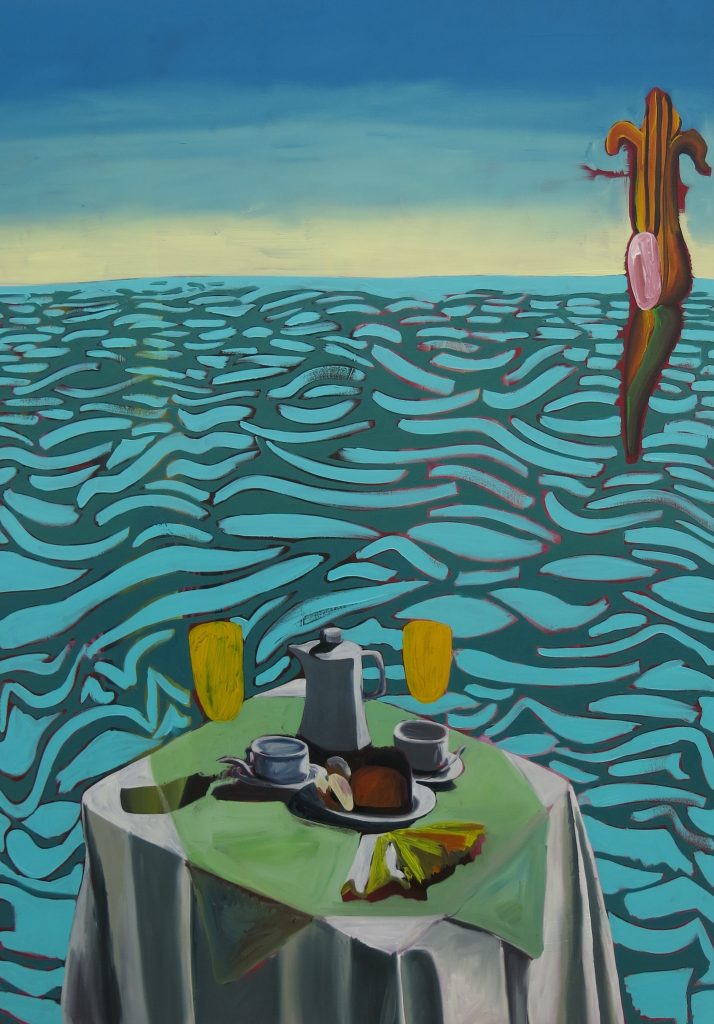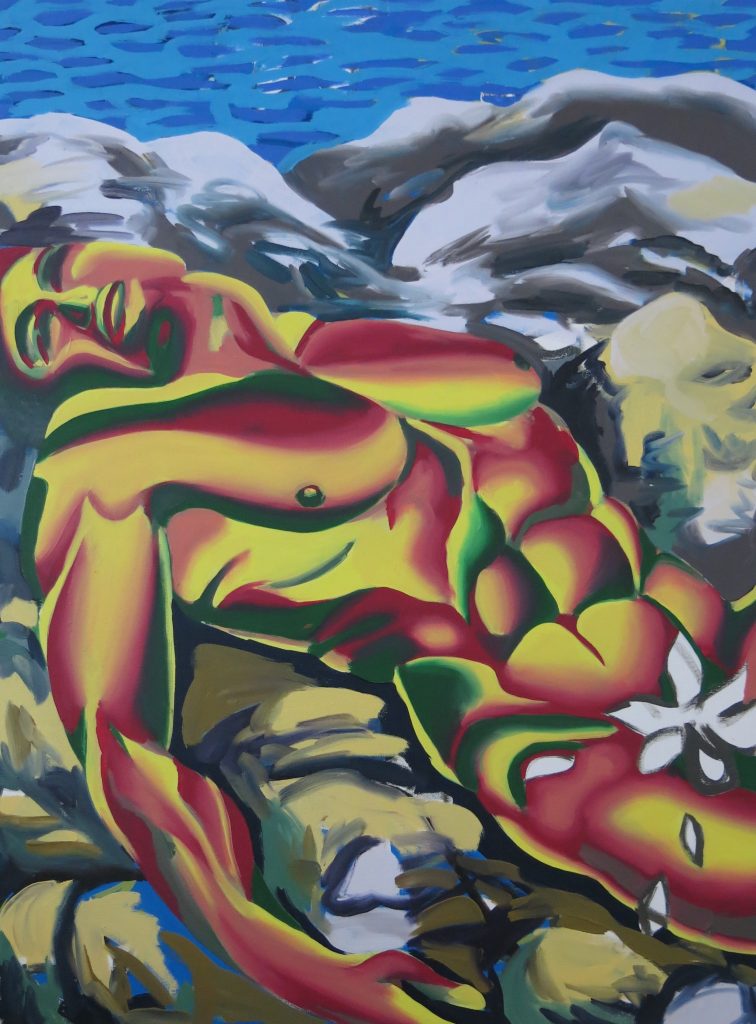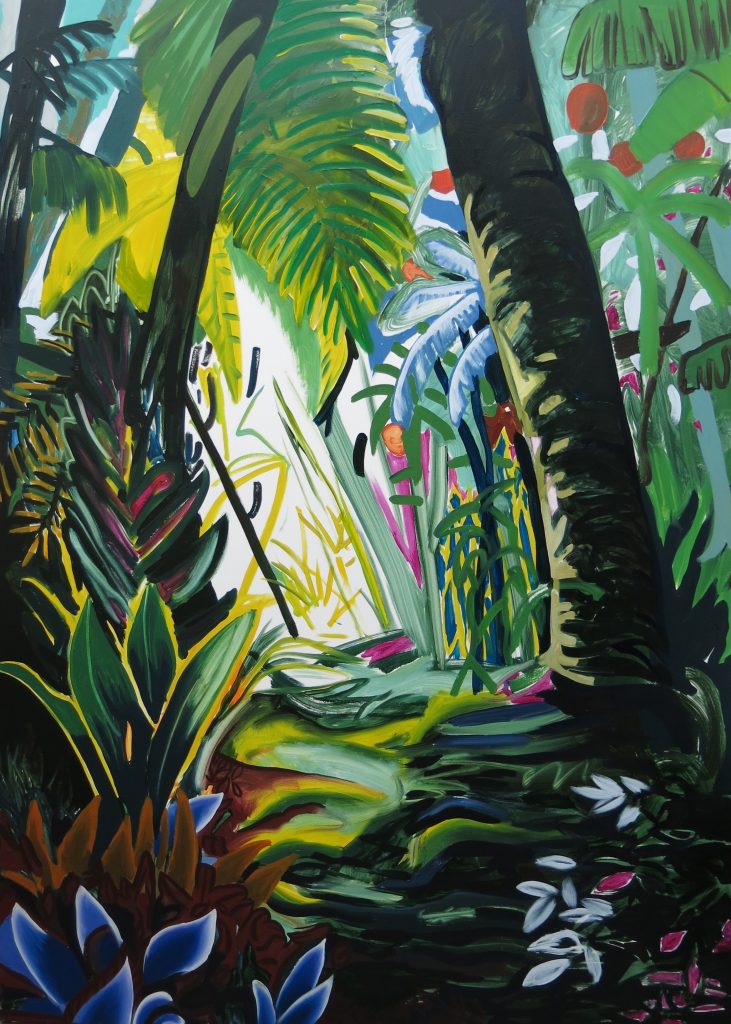I grew up on a farm in the north of France. As a kid, it was fun to go out in the summer, play hide and seek in the cornfields, tell scary stories at night in the woods, and jump in the giant piles of wheat. As a teenager, I became eager to meet new people, so I left for Paris as early as I could. If only cities weren’t so polluted, we’d be able to see the stars.
When did you realise that you wanted to be a painter?
Not until I was already enrolled in a painting programme. I wasn’t very conscious of the choice I was making at the time – I had barely painted before – once I was caught up, it was too late for me: I did not (and could not) do anything else.

I’m Avocado. Margaux Valengin. 2016.
Do you remember the first ever piece of art that you ever sold as an artist?
During the second year of my BA, one of my tutors bought a painting off of me. I was quite puzzled.
What are you currently fascinated by and how is it feeding into your work?
Recently, I’ve been painting some muscled male torsos. At first, when I’m drawn to a subject, it’s subconscious. Then, eventually I realise (I don’t always though) what it’s about, and why I’m painting it. Those strong men probably represent my young animus – the male aspect in the female psyche. Inflated muscles show the need to impose myself in a patriarchal society. Paradoxically, these men are somewhat fragile: they show their beautiful plasticity, taking on poses and revealing a shallowness. I paint them with compassion and I think of crucifixions.
As you’re now living in New York, how would you compare the New York art scene to the London one? Which city do you prefer living in?
The art scene here is pretty much the same, seeing as the art world is globalised. The two cities feel very much the same; they are two globalised cities, rivers cross their centres. You can find the same things to buy and eat, and it’s the same struggle to make your rent. What makes them different is the people that inhabit them – after all, it’s people that make a city. Everyone has their own impression of a city because of where he or she goes and the people they meet there. The idea that I have of London is embedded in the experience of living among my university peers. Missing a place, to me, means missing the people from this place.
What is your current workspace like?
I am painting in my flat, as I can’t afford to rent an art studio in NYC.
Is there a particular object in your studio that sparks joy for you, or inspires you?
A monstrous, delicious plant, Haitian music and two masks: a Songye and a Mambila from Nigeria and Zaire, respectively.
Do you ever paint from dreams?
I don’t, but I love dreaming; dreams are inspiring material for one’s life. I think everybody should take great consideration of their dreams. There’s a tribe from South America whose people believe that if one doesn’t remember their dream the day after they’ve dreamt it, there may be something wrong with them. If one doesn’t remember their dream for two consecutive days, then this person is probably sick.
Is it strange looking back at your previous paintings now, as if you’re re-reading a diary from the past? Is there a painting you’ve painted that you’re particularly proud of?
I like some of my paintings more than others, but there is no feeling of pride. There may be feelings of excitement and joy from the making of them, but it’s very ephemeral. I look at my older work to try to understand what I am doing and why, looking at both the ‘bad’ and the ‘good’ paintings I made.
Which book has had the biggest impact on your life and work?
I just finished reading The New Jim Crow: Mass Incarceration in the Age of Colorblindness by Michelle Alexander. I’m outraged reading every page. I cannot believe the time we live in and I feel stupid being a painter.

Dying on Christmas. Margaux Valengin. 2016
If you could put a spotlight on an emerging artist that you think deserves it, who would you choose?
I would like to draw people’s attention to the work of Pedro Ruxa Corriera. Pedro is a painter from Portugal that I admire both for his very distinct way of handling paint and for his metaphysical approach to the medium. His stroke is often sparse, as if made with a very worn out brush and the paint is nicely matte. Through his way of painting carefully-selected pictures, he makes a crucial comment on how we look at images today. Pedro Ruxa Corriera gives materiality to images and retracts their obituaries.
If you could get any artist from history to paint your portrait, who would you choose?
Albert Oelhen.
If you could choose two artists from history to have dinner with, who would you choose and why?
It would be nice to meet my masters, painters whose work thrills me, but I would be so embarrassed that I would not be able to utter a word, so maybe I would pick writers. It’s not that I admire writers less – in fact I would probably be just as embarrassed – but it would be different because their materials are words. It would be nice to share some food with the ghosts of Roland Barthes and James Joyce.
Margaux Valengin’s paintings will be exhibited in the group show, The World’s Mine Oyster, opening on 8th December at 6pm, 133 Bethnal Green Road, London.







